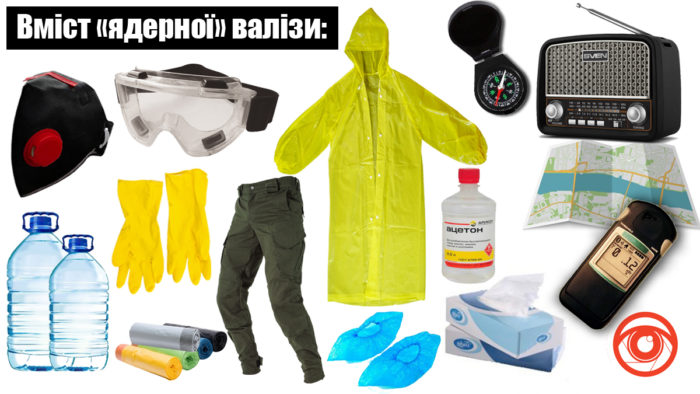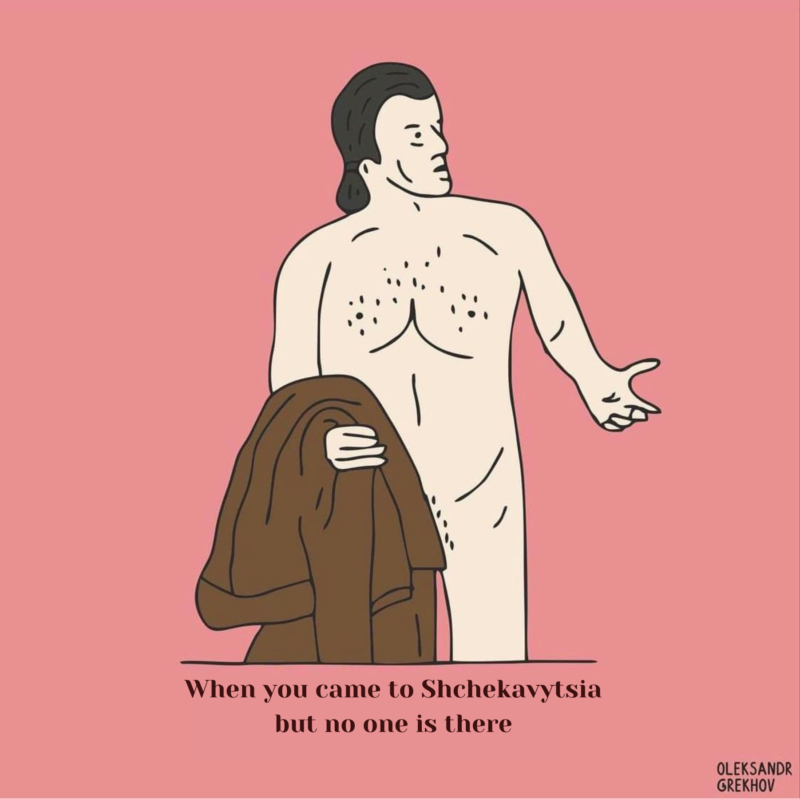Concerns about the possibility of a nuclear strike on Ukraine grew in late September after President Putin threatened Ukraine with “various means of attack.” In addition, shortly after Putin’s September speech, Dmitry Medvedev, ex-president and deputy chairman of Russia’s Security Council, wrote that Russia “has the right to use nuclear weapons if necessary.” While the threat of Russia using nuclear weapons is deemed unlikely, US intelligence officials believe it has risen to its highest since the Russian invasion on 24 February 2002.
What goes into a “nuclear backpack”?
Experts argue that Russia will not use nuclear weapons. Instead, it is simply using nuclear blackmail to prevent the West from supplying Ukraine with heavy weapons. For many Ukrainians, though, the current situation resembles the months preceding February’s full-scale invasion. Even those who believe a nuclear strike on Ukraine is unlikely are preparing for all possible scenarios. The “emergency suitcase” packed for a possible evacuation became one of the earliest symbols of the potential nuclear threat. Many later said it was helpful in a timely evacuation, if not life-saving. Now, some Ukrainians are packing “emergency nuclear backpacks.”
In October, the state-funded Center for Strategic Communications and Information Security (CSCIS) issued guidelines on what to do in the event of a nuclear attack.
“The use of nuclear weapons against Ukraine is considered unlikely. The ultimate purpose of these threats is to scare Ukrainians and the rest of the world, compel us to make concessions, and weaken our allies’ support for Ukraine. However, Russia’s intimidation will not have the desired effect. At the same time, Ukrainians must have an action plan in case of any emergency, such as nuclear weapons or a ‘dirty bomb,’ or an accident at a nuclear power plant,” the statement reads.
The instructions outline what to do after an attack, making clear that the chances of survival are proportional to the level of preparedness. Thus, it is the availability of protection suits, bottled water, respirators, and so on.
“Strange as it may sound, surviving a nuclear strike is more likely than dying,”
writes Roman Pavliuk, a telecommunications and radio systems expert who has extensively researched radiation. His Facebook post about preparations for a nuclear strike on Ukraine was shared 7,000 times.
“I will start by saying that I will not evaluate the probability or improbability of nuclear weapons entering our territory y. I assume it unlikely but possible,” Pavliuk states.
His post contains a list of products that should be obtained without delay to protect oneself against radioactive fallout, which would begin about 10 minutes after the initial explosion and radioactive rain.
In countless posts on social media, Ukrainians share with friends that they have already bought respirators and gas bottles (the latter for the failure of electricity and heating); protective suits and gas masks (the latter giving more protection than respirators); and reserves of water and food. Many parents are checking that their children’s school is prepared with the necessary dosage of potassium iodide for students in case of a nuclear attack.

- Two pairs of dense, semi-synthetic-fabric, comfortable pants, preferably military style.
- Five pcs of polyethylene raincoats.
- Five to ten pairs of overshoes medical types.
- A roll of trash bags, preferably thick ones.
- Six Respirators FFP2, better yet, FF 3. (It is recommended to use those Ukrainian-made ones, each in a separate package.)
- Strong, well-reinforced binding tape.
- Four pairs of industrial rubber gloves.
- One pair of safety goggles, such as those used when working with a grinder.
- Three packs of paper napkins.
- Two nail polish remover bottles.
- Three liters of water in a polyethylene contain r. The thicker the sides, the better.
- Mechanical compass (not relying on a smartphone).
- Terrain maps, purchased or printed from the Internet, and pencils and pens.
- And, most importantly, a Geiger counter, also known as a radiation detector. One per family, including a power bank and/or batteries.
- (Optional) A radio receiver with a CX/X range. However, assume there will be no communication with the central station, as an explosion will destroy it.
The main difference between these recommendations and those issued by authorities is that the latter suggests going into the basement or other buildings and listening for instructions via a radio receiver. However, Pavliuk assumes that the central station will be destroyed and that no instructions will be sent via radio receivers. The receiver is the only electrical appliance that can survive the electromagnetic pulse, which will disable all electrical devices at the moment of the nuclear explosion. That is why Pavliuk also recommends having maps, as it is likely that vehicles will be inoperable, and commute will have to be done on foot.
Pavliuk recommends wearing a mask, gloves, and a raincoat or protective suit sealed with heavy tape immediately following the explosion – polyethylene intercepts alpha and beta radiation. It is critical to hold on for two days. The radiation level should return to normal after 48 hours.
Instructions to survive a nuclear strike on Ukraine
Depending on what resources one has, two additional options exist for what to do following the explosion:
First: As described above, those who have enough water and food and are in a safe shelter but do not have a radiation detector or protective equipment should stay there for the next 12-24 hours. It is difficult to determine whether the danger is greater inside or outside. Remember, contaminated air will seep into the structure of a shelter, and respiratory organs must be thoroughly protected, even if no respirators are available. The best protection is to apply gauze bandaging as soon as possible; wear clean clothes; and use a medical mask, a shawl, or other layers to protect your breathing.
Second: Those with a still-functioning radiation detector and the personal protection described above can leave the affected area one hour after the explosion. However, if they detect extreme radiation levels (more than 100 μR/h) while attempting to exit, they must return to the shelter and try to leave again in 12–24 hours. If the radiation level is not extreme, one can walk to a location with lower radiation levels, constantly checking the radiation level with a detector, changing masks (every 3 hours), and changing raincoats (every 8 hours). Walking at least 10-15 km to reach a safety zone will be necessary.
Ukrainians buy large quantities of potassium iodide pills. A relative who is a doctor recently gave a friend a pair of pills. Potassium iodide is used to saturate a person’s thyroid with iodine, preventing the gland from retaining inhaled or ingested radioactive iodide. According to a pharmacist in Kyiv, customers were coming in daily looking for the pills, but she “hasn’t seen people panicking about it.”
Following Ukrainian authorities’ plans to distribute potassium iodide in the event of a tangible threat, local officials in the Polish city of Lublin (near the Ukrainian border) are preparing to publish the locations’ addresses where residents can obtain potassium iodide.
“Orgy” on Shchekavytsia hill
However, the “nuclear [emergency] backpack” in response to a possible nuclear strike is not the most discussed topic in Ukraine. The focus of attention is actually a so-called “orgy” on the Kyiv hill of Shchekavytsia in the event of a nuclear explosion.
Following Nataliya Piskova’s tweet on 22 September, a wave of orgy memes began. She wrote that a secret Telegram chat exists whose members plan to gather on the famed Kyiv hill of Shchekavytsia, named after Shchek, one of Kyiv’s three founding brothers, which rises above the Dnipro river and gives a good view of the city.
“When it [danger of nuclear strike] begins, immediately go to Shchekavytsia, don’t ask too much, you’re not little children,” she said in a tweet that went viral.
A Telegram chat was created, and an influx of jokes and memes erupted.
“I will be in Shchekavytsia in red sneakers … and with a cross [on my neck chain],” tweeted Biichuk Roman.

Soon, everyone forgot about the danger of a nuclear strike. Shchekavytsia soon became the focus of attention and nationwide jokes and memes. A way to psychologically cope in the face of mortal danger. Another way to flout the Russian threat is through irony and sardonic jokes, which Ukrainians have become famed for throughout these eight months of the war.
Twitter user, Zakrevska, tweeted a joke about how descendants of Ukrainian survivors will react to war stories in the future.
“Granny, how did you prepare for the 2022 nuclear attack?”
“Well, they set a Twitter chat to agree on Sodom and Gomorrah on Shchekavytsia and then flooded it with jokes.”
“Sure… okay, Granny… go take your pills now.”
“Due to the increasing number of COVID-19 cases, the Ministry of Education and Culture recommends that participants in the Shchekavytsia ‘Orgy’ observe anti-epidemic norms and keep at least 2 meters apart,” tweeted Ukrainian internet publication Ukrayinskyi Vishchun (Ukrainian Prophet).
Businesses were also caught up in the Shchekavytsia’s tidal wave on Twitter. Silpo supermarket tweeted that customers should not be concerned about long queues near Shchekavytsia because service will be quick and efficient thanks to the store’s 16 cash registers.
Another Twitter user named Gnojevik wrote, “Based on the number of participants in the Shchekavytsia chat, one can form a battalion.”
Local context: where can one find “Shchekavytshia” in other cities?
Much of the Shchekavytsia orgy humor is based on folk songs with familiar lyrics and historical events – music and topography can be challenging to translate from the vernacular, adding to the orgy theme’ allure. Even more intriguing is how the “Shchekavytsia Plans” were created, tailoring them to the needs of individual communities. Some simply propose a different orgy mountain closer to the city or town. However, many discussions focused on whether an orgy was even possible in Lviv. There the population is predominantly Ukrainian Catholic and generally perceived as devout parishioners.
https://twitter.com/densudi/status/1574668478157443072?ref_src=twsrc%5Etfw%7Ctwcamp%5Etweetembed%7Ctwterm%5E1574668478157443072%7Ctwgr%5E49a03a2ed676655dc3c8aa2d6af373c04f657442%7Ctwcon%5Es1_&ref_url=https%3A%2F%2Fnews.lviv-company.in.ua%2Fsvit-loviv-mene-ale-ya-pod197xav-na-shhekavicyu-kiyani-gotuyutsya-do-orgid197-na-vipadok-yadernogo-udaru.html
In response to Liena Chychenina’s Twitter question about whether an orgy could be held in Lviv, Roman Tymchyshyn wrote,
“This is ‘Holy Galicia.’ Can you imagine attendees at an orgy greeting one another with ‘Glory to Jesus Christ‘?”
He was referring to the common religious greeting widely used in the west of Ukraine, particularly in its rural areas.
Another Twitter user included another local flavor to their tweet that there would be no orgy in Lviv. “There will be dinner here, followed by tasting local liqueurs. Following the tasting, there will be a patriotic songs festival. After that, there will be a Procession of the Cross, ending with a hackathon,” alluding to Lviv’s most profitable business sectors, tourism and IT.
Even the BBC’s Ukrainian office visited Shchekavytsia and interviewed people milling about. Initially, people joked with journalists in response to their questions about the orgy. They then gradually shifted to a (slightly) more serious tone, “To be serious, what orgy are you talking about? In the best-case scenario, people will come here to roar.”
“It’s so Ukrainian to make plans for love, sex, and basic survival in the face of threat. Why worry when you can have fun?” Anna, a Shchekavytsia orgy chat member, told the BBC reporters. “The chat is more about Ukrainian optimism. It’s about our stability and endurance.”
The best way to interpret the Shchekavytsia Orgy is as a metaphor for prevailing fearlessly over cowardly Russian blackmail and threats. With the most cowardly of all being the threat of a nuclear bomb.
Related:
- What if Russia nukes Ukraine? Military strategist Lawrence Freedman explains
- Russian nuclear strike would almost certainly draw “physical response,” NATO official said
- “I don’t see Putin using nuclear weapons” – military strategist Lawrence Freedman
- US hasn’t yet seen any action indicating Russia contemplating nuclear attack – US State Sec Blinken
- US will have to get “fully involved” if Russia goes nuclear – Former Commander Army Europe
- “I don’t see Putin using nuclear weapons” – military strategist Lawrence Freedman






